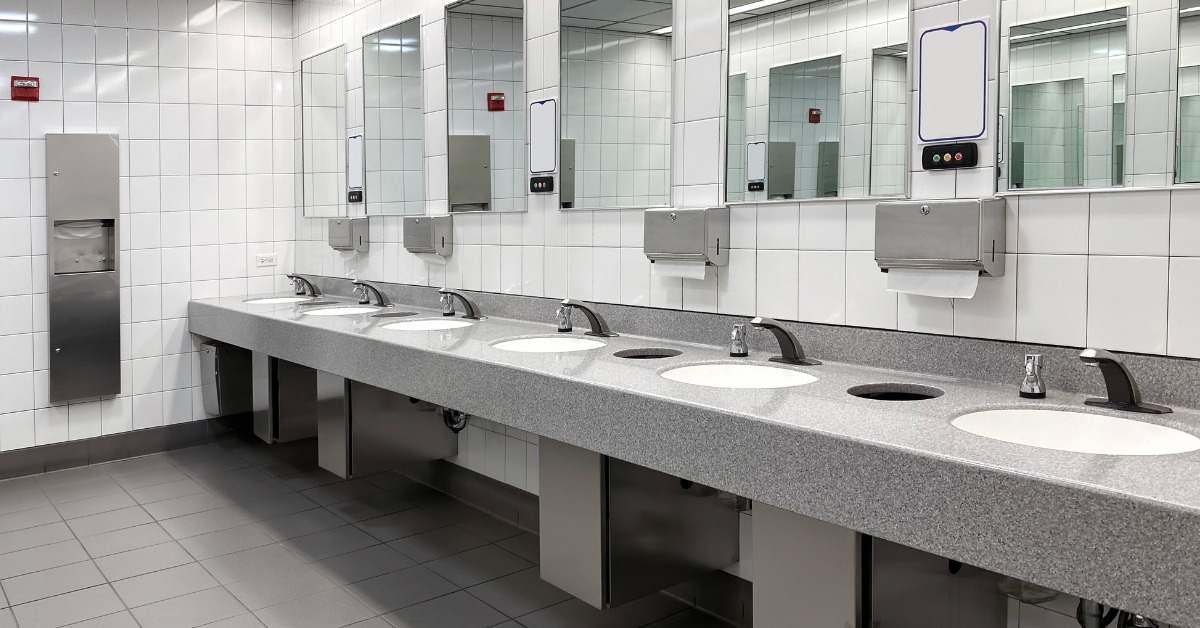
COVID-19 has taught us a lot and brought about many changes in the world. In 2019, few people had heard of physical distancing or spike proteins, but it’s now part of everyday life.
Back then, we visited shops, restaurants, and public washrooms without considering the risk of an infection with a complicated coronavirus. Most individuals and businesses in Australia are now on top of the essential precautions needed to keep the community safe and stop the spread of COVID-19.
Why Washrooms are High-Risk Settings
Research and overseas experience have shown some indoor locations are more high-risk than others. There are a few reasons why a person is more likely to be infected with COVID-19 in a washroom than in any other setting.
Small Size
Most washrooms aren’t spacious. In some, social distancing is impossible once two or three people enter. If someone infected with COVID-19 coughs or sneezes, most of the washroom can become contaminated with aerosols that hang in the air waiting to be breathed in by another person.
Frequently Touched Surfaces
Many of the washroom's surfaces are frequently touched - the door handle to go in and out, the lock on the stall, the button on the water closet, the tap, the dryer, and many more. These hard surfaces are prime locations for passing the virus to multiple visitors after an infected person has been there. Even people with meticulous personal hygiene would struggle to escape without a trace of the virus on their hands.
Poor Air Flow
In high-rise buildings and shopping centres, washrooms are usually positioned in the middle, away from external windows and doors. Their internal position means they don’t have the benefit of fresh outdoor air replacing the indoor air. This means the air conditioning and extraction fans are responsible for potentially infected air going out and fresh, clean air coming in.
Aerosols Produced by Toilet Flushing
There are concerns toilets could be spreading COVID-19 due to flushing, generating aerosols that linger in the air. A recent report by The Medical Journal of Australia highlighted examples of how coronavirus was spreading via airborne transmission.
The Medical Journal report referenced an outbreak in South Korea, where only residents living in apartments connected by a ventilation shaft got infected with the virus. All seven affected apartments (out of 200) were located along the vertical line of the shaft, suggesting a ‘stack effect' carried virus-laden aerosols into residents' bathrooms.
A similar outbreak occurred in an apartment building in China, where the virus appeared to spread from people on the 15th floor to people in vertically aligned flats on floors 25 and 27 via dried-out floor or bath drains. Faecal aerosols produced by toilet flushing were thought to be responsible.
What We Can Do to Make Washrooms Safe
Making indoor spaces completely safe against COVID-19 infections is challenging, but washrooms are some of the most demanding areas. They are confined spaces with a high number of visitors touching multiple surfaces. However, there are steps organisations can take to prevent the spread of COVID.
Increase Cleaning Frequency
The increased number of high touch points in a washroom means there is a need for frequent cleaning. Wiping over handles, taps, and buttons multiple times per day with a disinfectant will reduce the risk of these points becoming super spreader sites if a COVID-19-infected person visits.
Improve Air Extraction
Commercial washrooms have exhaust systems, but not all of them work efficiently. Poorly maintained systems can’t achieve the minimum number of air changes per hour. By servicing or repairing a unit, it’s possible to increase the number of air changes and reduce the risk of infection.
Encourage Physical Distancing
Busy public washrooms often have a lot of people waiting in line for the next available stall. The tight space means the queue rarely has 1.5 metres between each person. Queuing outside will make it easier to maintain a safe distance.
Use High-Grade Cleaning Products
A regular cleaning product may not be sufficient to reduce or stop the spread of coronavirus. Cleaning products tested and found to be effective against the spread of the COVID-19 virus are labelled.
Our Chlor-Clean product was certified for use against COVID-19 early in the pandemic. Use the Chlor-Clean liquid with single-use or washable cloths. Remember to change clothes throughout the day and wash in hot water with detergent.
If you’re looking for a safe, efficient and effective disinfectant cleaner, check out the range of Chlor-Clean products, available in tablet form for dissolving in one litre of water and as disinfectant wipes. It is a hospital-grade disinfectant that can keep any washroom sanitised.
Using Floor Drain Technology to Stop Disease-Spreading Pathogens
Pipes and open and exposed drains are potential sources of contamination that provide a habitat for pathogens, especially in the biofilm. Installing products like a floor drain trap seal can help stop infection transmission. The Green Drain has a flexible silicone membrane that lets water run through and instantly closes and seals as soon as the water stops flowing.
Hospitals are especially prone to pathogens potentially transmitted through pipes and exposed drains. Reducing the spread of infections is essential in a facility caring for vulnerable people, such as aged care locations and other high-risk settings. Installing Green Drain in aged care and healthcare settings can help prevent airborne contaminants from spreading between rooms and wards. This will aid against disease and illness.
For more information about effective cleaning products against COVID-19, call Helix Solutions on 1300 29 32 32 or contact us online.